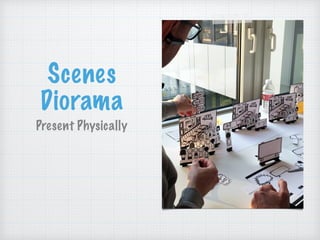Applying SAP Scenes
- 1. Applying SAP Scenes presenter: Sasmito AdibowoŌĆ© date: 8 Sep 2016ŌĆ© information classi’¼ücation: Public
- 2. Why Scenes?
- 3. Why Scenes?
- 4. Why Scenes?
- 5. Why Scenes?
- 6. Why Scenes?
- 7. What can you do?
- 8. What can you do? Diorama
- 9. What can you do? Diorama Pitch
- 10. What can you do? Diorama Pitch Video
- 18. Pitch Kit Impress your investors and business partners
- 20. Six ║▌║▌▀Żs to Success 1. Cover + Identity 2. Elevator Pitch 3. Customer Situation 4. Your Solution 5. Desired Outcome 6. Thanks + Contact Info
- 21. Introduce Yourself 1. Cover + Identity 2. Elevator Pitch 3. Customer Situation 4. Your Solution 5. Desired Outcome 6. Thanks + Contact Info
- 22. Introduce Yourself 1. Cover + Identity 2. Elevator Pitch 3. Customer Situation 4. Your Solution 5. Desired Outcome 6. Thanks + Contact Info
- 23. Issue Invoice Receive Payment Clear Payment Capture Interest 1. Cover + Identity 2. Elevator Pitch 3. Customer Situation 4. Your Solution 5. Desired Outcome 6. Thanks + Contact Info
- 24. They are not updating the system again! Sales manager do not have the latest status of all opportunities when sales representatives do not update the system promptly. State the Problem 1. Cover + Identity 2. Elevator Pitch 3. Customer Situation 4. Your Solution 5. Desired Outcome 6. Thanks + Contact Info
- 25. LexCorp Closed Win Probability Action Recommendation How it Works 1. Cover + Identity 2. Elevator Pitch 3. Customer Situation 4. Your Solution 5. Desired Outcome 6. Thanks + Contact Info
- 26. Organization Success Operational Cost Time to hire Satisfaction Employer Branding 30 mins Yes! I have the job interview from the company I like! The "After" Shot 1. Cover + Identity 2. Elevator Pitch 3. Customer Situation 4. Your Solution 5. Desired Outcome 6. Thanks + Contact Info
- 27. Where to Find You 1. Cover + Identity 2. Elevator Pitch 3. Customer Situation 4. Your Solution 5. Desired Outcome 6. Thanks + Contact Info
- 28. Explainer Video Sell to the Internet
- 29. An insect is extraordinarily stupid and inadaptable to all things not related to its instincts. Nevertheless I succeeded in teaching a water-beetle (Dytiscus marginalis) which in nature feeds only in the water, to eat on my table. While thus feeding, it always executed a clumsy ’¼éexor-movement with its fore-legs which brought it over on its back. The insect learned to keep on feeding while on its back, but it would not dispense with this movement, which is adapted to feeding in the water. On the other hand, it always attempted to leap out of the water (no longer ’¼éeeing to the bottom of the vessel) when I entered the room, and nibbled at the tip of my ’¼ünger in the most familiar manner. Now these are certainly plastic variations of instinct. In a similar manner some large Algerian ants which I transplanted to Zurich, learned during the course of the summer months to close the entrance of their nest with pellets of earth, because they were being persecuted and annoyed by our little┬ĀLasius niger. In Algiers I always saw the nest-opening wide open. There are many similar examples which go to show that these tiny animals can utilize some few of their experiences even when this requires a departure from the usual instincts.┬Āmore That ants, bees, and wasps are able to exchange communications that are understood, and that they do not merely titillate one another with their antenn├” as Bethe maintains, has been demonstrated in so many hundred instances, that it is unnecessary to waste many words on this subject. The observations of a single predatory expedition of Polyergus, with a standing still of the whole army and a seeking for the lost trail, is proof su’¼ācient of the above statement. But, of course, this is not language in the human sense!┬ĀThere are no abstract concepts corresponding to the signs. We are here concerned only with hereditary, instinctively automatic signs. The same is true of their comprehension (pushing with the head, rushing at one another with wide-open mandibles, titillation with the antenn├”, stridulatory movement of the abdomen, etc.). Moreover, imitation plays a great r├┤le. Ants, bees, etc., imitate and follow their companions. Hence it is decidedly erroneous (and in this matter Wasmann, Von Buttel, and myself are of but one opinion) to inject human thought-conception and human ratiocination into this instinct-language, as has been done to some extent, at least, even by Pierre Huber, not to mention others. It is even very doubtful whether a so-called general sensory idea (i. e., a general idea of an object, like the idea ŌĆ£ant,ŌĆØ ŌĆ£enemy,ŌĆØ ŌĆ£nest,ŌĆØ ŌĆ£pupaŌĆØ) can arise in the emmet brain. This is hardly capable of demonstration. Undoubtedly perception and association can be carried on in a very simple way, after the manner of insects, without ever rising to such complex results. At any rate proofs of such an assumption are lacking. But what exists is surely in itself su’¼āciently interesting and important. It gives us at least an insight into the brain-life of these animals.┬Ā Better than any generalizations, a good example will show what I mean. Plateau had maintained that when Dahlia blossoms are covered with green leaves, bees nevertheless return to them at once. At ’¼ürst he concealed his Dahlias incompletely (i. e., only their ray-’¼éorets), afterwards completely, but still in an unsatisfactory manner, and inferred from the results that bees are attracted by odor and not by sight. 2 In a Dahlia bed visited by many bees and comprising about forty-three ’¼éoral heads of di’¼Ćerent colors, I covered ’¼ürst seventeen and then eight at 2.15 P. M., September 10th, with grape-leaves bent around them and fastened with pins. 3 Of four I covered only the yellow disc; 4 Of one, on the other hand, I covered only the outer ray-’¼éorets, leaving the disc visible. So many bees were visiting the Dahlias that at times there were two or three to a ’¼éower. Result: Immediately all the completely covered ’¼éowers ceased to be visited by the bees. Dahlia (c) continued to be visited like those completely visible. The bees often ’¼éew to Dahlias (b) but at once abandoned them; a few, however, succeeded in ’¼ünding the disc beneath the leaves. Then as soon as I removed the covering from a red Dahlia the bees at once ’¼éew to it; and soon a poorly concealed specimen was detected and visited. Later an inquisitive bee discovered the entrance to a covered Dahlia from the side or from below. Thenceforth this bee, but only this one, returned to this same covered ’¼éower. Nevertheless several bees seemed to be seeking the Dahlias which had so suddenly disappeared. Towards 5.30 oŌĆÖclock some of them had detected the covered ’¼éowers. Thenceforth these insects were rapidly imitated by the other bees, and in a short time the hidden ’¼éowers were again being visited. As soon as a bee had discovered my imposition and found the entrance to a hidden ’¼éower, she ’¼éew in her subsequent journeys, without hesitation to the concealed opening of the grape-leaf. As long as a bee had merely made the discovery by herself, she remained unnoticed by the others. When this was accomplished by several, however, (usually by four or ’¼üve,) the others followed their example. Plateau, therefore, conducted his experiments in a faulty manner and obtained erroneous results. The bees still saw the Dahlias which he at ’¼ürst incompletely concealed. Then, by the time he had covered them up completely, but only from above, they had already detected the fraud and saw the Dahlias also from the side. Plateau had failed to take into consideration the beeŌĆÖs memory and attention. September 13th I made some crude imitations of Dahlias by sticking the yellow heads of Hieracium (hawkweed) each in a Petunia ’¼éower, and placed them among the Dahlias. Neither the Petunias nor the Hieracium had been visited by the bees. Nevertheless many of the honey and humble-bees ’¼éew at ’¼ürst to the artifacts┬Āin almost as great numbers as to the Dahlias, but at once abandoned the ’¼éowers when they had detected the error, obviously by means of their sense of smell. The same results were produced by a Dahlia, the disc of which had been replaced by the disc of a Hieracium. As a control experiment I had placed a beautiful, odorous Dahlia disc among the white and yellow Chrysanthemums which had been neglected by the bees. For a whole half hour the bees ’¼éew by only a few centimeters above the disc without noticing it; not till then was it visited by a bee that happened to be followed by a second. From this moment the Dahlia disc which lay in the path of ’¼éight was visited like the others, whereas on the other hand the Petunia-Hieracium artifacts, now known to be fraudulent, were no longer noticed. Plateau has demonstrated that arti’¼ücial ’¼éowers, no matter how carefully copied from the human standpoint, are not noticed by insects. I placed artifacts of this description among the Dahlias. They remained in fact entirely neglected. Perhaps, as above suggested, the bees are able to distinguish the chlorophyll colors from other arti’¼ücial hues, owing to admixtures of the ultra-violet rays, or by some other means. But since Plateau imagines that the arti’¼ücial ’¼éowers repel insects, I cut out, Sept. 19th, the following rather crude paper-’¼éowers: ╬▒. A red ’¼éower; ╬▓. A white ’¼éower; ╬│. A blue ’¼éower;
- 30. insects were rapidly imitated by the other bees, and in a short time the hidden ’¼éowers were again being visited. As soon as a bee had discovered my imposition and found the entrance to a hidden ’¼éower, she ’¼éew in her subsequent journeys, without hesitation to the concealed opening of the grape-leaf. As long as a bee had merely made the discovery by herself, she remained unnoticed by the others. When this was accomplished by several, however, (usually by four or ’¼üve,) the others followed their example. Plateau, therefore, conducted his experiments in a faulty manner and obtained erroneous results. The bees still saw the Dahlias which he at ’¼ürst incompletely concealed. Then, by the time he had covered them up completely, but only from above, they had already detected the fraud and saw the Dahlias also from the side. Plateau had failed to take into consideration the beeŌĆÖs memory and attention. September 13th I made some crude imitations of Dahlias by sticking the yellow heads of Hieracium (hawkweed) each in a Petunia ’¼éower, and placed them among the Dahlias. Neither the Petunias nor the Hieracium had been visited by the bees. Nevertheless many of the honey and humble-bees ’¼éew at ’¼ürst to the artifacts┬Āin almost as great numbers as to the Dahlias, but at once abandoned the ’¼éowers when they had detected the error, obviously by means of their sense of smell. The same results were produced by a Dahlia, the disc of which had been replaced by the disc of a Hieracium. As a control experiment I had placed a beautiful, odorous Dahlia disc among the white and yellow Chrysanthemums which had been neglected by the bees. For a whole half hour the bees ’¼éew by only a few centimeters above the disc without noticing it; not till then was it visited by a bee that happened to be followed by a second. From this moment the Dahlia disc which lay in the path of ’¼éight was visited like the others, whereas on the other hand the Petunia-Hieracium artifacts, now known to be fraudulent, were no longer noticed. Plateau has demonstrated that arti’¼ücial ’¼éowers, no matter how carefully copied from the human standpoint, are not noticed by insects. I placed artifacts of this description among the Dahlias. They remained in fact entirely neglected. Perhaps, as above suggested, the bees are able to distinguish the chlorophyll colors from other arti’¼ücial hues, owing to admixtures of the ultra-violet rays, or by some other means. But since Plateau imagines that the arti’¼ücial ’¼éowers repel insects, I cut out, Sept. 19th, the following rather crude paper-’¼éowers: ╬▒. A red ’¼éower; ╬▓. A white ’¼éower; ╬│. A blue ’¼éower; ╬┤ A blue ’¼éower, with a yellow center made from a dead leaf; ╬Ą. A rose-colored piece of paper with a dry Dahlia disc; ╬Č. A green Dahlia leaf (unchanged). It was nine oŌĆÖclock in the morning. I placed a drop of honey on each of the six artifacts mounted among the Dahlias. For a quarter of an hour many bees ’¼éew past, very close to my artifacts but without perceiving and hence without smelling the honey. I went away for an hour. On my return artifact ╬┤ was without honey, and must therefore have been discovered by the bees. All the others had remained quite untouched and unnoticed. With some di’¼āculty I next undertook to bring artifact ╬▒ very close to a bee resting on a Dahlia. But the attention of the bee was so deeply engrossed by the Dahlia that I had to repeat the experiment four or ’¼üve times till I succeeded in bringing the honey within reach of her proboscis. The insect at once began to suck up the honey from the paper-’¼éower. I marked the beeŌĆÖs back with blue paint so that I might be able to recognise her, and repeated the experiment with ╬▓ and ╬Ą. In these cases one of the bees was painted yellow, the other white. Soon the blue bee, which had in the meantime gone to the hive, returned, ’¼éew at once to ╬▒, ’¼ürst hovering about it dubiously, then to ╬┤, where she fed, then again to ╬▒, but not to the Dahlias. Later the yellow bee returned to ╬▓ and fed, and ’¼éew to ╬▒ and ╬┤ where she again fed, but gave as little heed to the Dahlias as did the blue bee. Thereupon the white bee returned seeking ╬Ą, but failing to ’¼ünd it, at once went to feeding on some of the Dahlias. But she tarried only a moment on each Dahlia as if tortured by the┬Āid├®e ’¼üxe┬Āof honey. She returned to the artifacts, the perception of which, however, she was not quite able to associate with the memory of the honey ’¼éavor. At last she found a separate piece of ╬Ą, which happened to be turned down somewhat behind, and began lapping up the honey. Thenceforth the three painted bees, and these alone, returned regularly to the artifacts and no longer visited the Dahlias. The fact is of great importance that the painted bees entirely of their own accord, undoubtedly through an instinctive inference from analogy, discovered the other artifacts as soon as their attention had been attracted by the honey on one of them, notwithstanding the fact that the artifacts were some distance from one another and of di’¼Ćerent colors. For were not the Dahlias, too, which they had previously visited, of di’¼Ćerent colors? Thus the blue bee ’¼éew to ╬▒, ╬▓, ╬│, and ╬┤, the yellow to ╬▓, ╬▒, ╬┤, and ╬│, the white ╬Ą, ╬▒, ╬▓, and ╬┤. Matters continued thus for half an hour. The hidden green ╬Č was not found, evidently because it was indistinguishable from the green foliage. Finally one bee, by herself, having had in all probability her attention attracted by the three others, came to ╬┤ and fed. I marked her with carmine. Thereupon she ’¼éew to ╬▒ and drove the blue bee away. Another bee was attracted to ╬Ą of her own accord and was painted with cinnobar. Still another bee came by herself to ╬▓ and was painted green. It was now 12.30 oŌĆÖclock. The experiment had therefore lasted more than three hours, and during this time only six bees had come to know the artifacts, while the great majority still kept on visiting the Dahlias. But now the other bees began to have their attention attracted by the visitors to the artifacts. One, then two, then three, and ’¼ünally more new ones followed, and I had not su’¼ācient colors with which to mark them. Every moment I was obliged to replenish the honey. Then I went to dinner and returned at 1.25. At this moment seven bees were feeding on ╬▓, two on ╬▒, one on ╬│, three on ╬┤, the white one alone on ╬Ą. More than half of all these were new, unpainted followers. Now a veritable swarm of bees threw themselves on the artifacts and licked up the last traces of the honey. Then for the ’¼ürst time, after more than four hours, a bee from the swarm discovered the honey on the artifact ╬Č, which on account of its color had remained concealed up to this time! As a pack of hounds throws itself on an empty skeleton, the swarm of bees, now completely diverted from the Dahlias, cast themselves on the completely empty artifacts and vainly searched every corner of them for honey. It was 1.55 P. M. The bees began to scatter and return to the Dahlias. Then I replaced ╬▒ and ╬▓ by a red and white paper respectively, which had never come in contact with honey and could not therefore smell of the substance. These pieces of paper, nevertheless, were visited and examined by various bees, whose brains were still possessed with the ’¼üxed idea of the ’¼éavor of honey. The white bee, e. g., investigated the white paper very carefully for a period of three to four minutes. There could, of course, be no such thing as an unknown force or attraction of odor, or brilliancy of ’¼éoral colors. This fact can only be explained by an association of space, form, and color memories with memories of taste.
- 33. Hipmunk Explainer Video by Grumo Media
- 34. Hipmunk Explainer Video by Grumo Media
- 35. Structure Your Script Duration Seconds 0 30 60 90 120 156045 Problem & Solution How it Works? Call to Action
- 36. Acknowledgments SAP Scenes CC-BY-NC-SA https://bit.ly/sapscenes https://experience.sap.com/skillup/scenes- new-method-tool-create-storyboards/ Hipmunk Explainer Video https://youtu.be/6teBPUgz4Y8




































